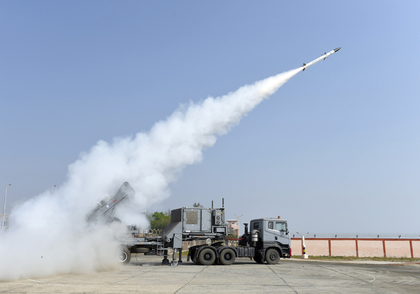Pakistan’s imported weaponry no match against India’s indigenous missile systems
By IANS | Updated: May 9, 2025 15:07 IST2025-05-09T15:01:09+5:302025-05-09T15:07:34+5:30
New Delhi, May 9 India’s homegrown missile systems are proving to be a formidable deterrent to Pakistan’s imported ...

Pakistan’s imported weaponry no match against India’s indigenous missile systems
New Delhi, May 9 India’s homegrown missile systems are proving to be a formidable deterrent to Pakistan’s imported military assets. As part of the Central government’s 'Atmanirbhar Bharat' initiative in the defence sector, Indian indigenous systems like the Akash missile have significantly bolstered the country’s military capabilities.
The Akash surface-to-air missile system, developed by the Defence Research and Development Organisation (DRDO), recently successfully shot down a Pakistani JF-17 fighter jet in the Pathankot sector. This achievement underlines India’s growing self-sufficiency in defence technology and its effectiveness in active combat situations.
In response to its impressive performance, the Akash system is now being deployed on a larger scale along forward areas. Both the Indian Army and the Indian Air Force are currently equipped with the missile system, particularly in sectors along the Pakistan border.
The Akash missile is a medium-range system with a strike range of 25 to 30 km. Operating under radar-based command guidance, it is capable of intercepting and destroying aircraft, drones, and cruise missiles with high accuracy.
The system can be launched from mobile platforms, making it versatile and adaptable to different terrains.
The Pakistani jet downed by Akash was a JF-17, a fighter aircraft jointly developed by China and Pakistan. However, Pakistan remains heavily dependent on China for the supply, maintenance, and operational training related to these aircraft.
Analysts point out that this dependency limits Pakistan’s understanding of the full capabilities of its imported platforms.
Pakistan has also used Chinese JF-10 aircraft and, in some cases, violated international agreements by deploying US-supplied F-16s against Indian targets, including civilian areas.
Furthermore, Pakistan launched drone and missile strikes on Indian cities including Jammu, Pathankot, Amritsar, Chandigarh, and several areas in Rajasthan. Indian air defence systems successfully intercepted and neutralised these threats.
In addition to the Akash, India fields several advanced air defence platforms such as the ZU-23, L-70, and Shilka systems -- all of which contribute to a robust, multi-layered air defence shield.
These systems, many of them indigenously produced or upgraded, continue to play a critical role in thwarting enemy incursions.
India’s growing reliance on domestically developed defence technologies stands in sharp contrast to Pakistan’s dependence on foreign suppliers.
Experts note that this disparity gives India a strategic advantage, not only in terms of operational independence but also in long-term sustainability and adaptability in modern warfare.
Disclaimer: This post has been auto-published from an agency feed without any modifications to the text and has not been reviewed by an editor
Open in app